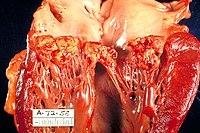
Photo from wikipedia
The problem of increasing microbial antibiotic resistance antimicrobial requires a detailed study of all antimicrobial drugs’ spectrum of activity. In the available literature, there are no data on microbial flora… Click to show full abstract
The problem of increasing microbial antibiotic resistance antimicrobial requires a detailed study of all antimicrobial drugs’ spectrum of activity. In the available literature, there are no data on microbial flora in vitro susceptibility to picloxydine. The aim of this study was to study the conjunctival flora composition and its susceptibility to antimicrobial drugs in patients before phacoemulsification, and to detect the conjunctival flora sensitivity to picloxydine in the postoperative period. Materials and methods . Before phacoemulsification, 117 swabs (116 patients) were taken from the conjunctiva before any drop instil lation. All swabs were examined using the routine cultural method and 14 antibiotics-panel susceptibility testing. Picloxydine susceptibility was tested four times during the postoperative period in 28 patients. Results . In 66.7%, bacterial growth was obtained preoperatively. All isolates were gram-positive, St. epidermidis was found most frequently (78.8%). In 1 hour after surgery, bacterial growth was obtained in 27.6%. Fluoroquinolones, linezolid, and picloxydine revealed highest efficacy toward St. epidermidis and St. aureus. Conclusion . Moxifloxacin, linezolid, and picloxydine turned out to be the most effective antimicrobial drugs. Сonjunctival flora was detected in 1 hour after phacoemulsification. Сonjunctival flora remains sensitive to picloxydine during 1 month in the postoperative period.
Journal Title: Ophthalmology
Year Published: 2018
Link to full text (if available)
Share on Social Media: Sign Up to like & get
recommendations!